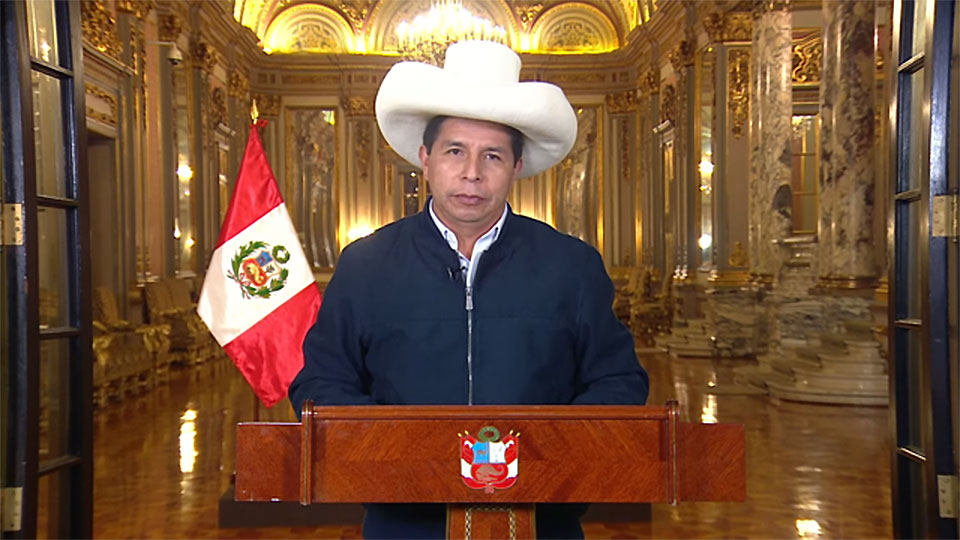
Peruvian president Pedro Castillo took office July 28 following a narrow electoral victory on June 6 and official certification of voting results on July 19. Then and since, right-wing opposition forces have viciously attacked Castillo and his Perú Libre (Free Peru) party. Defamatory media blasts from virtually all Peruvian news sources have been constant. Unfounded accusations of electoral fraud persisted for weeks, along with rumors of a military coup. The opposition recently has concentrated on trying to remove newly appointed cabinet ministers.
Pedro Castillo taught and served as principal in an elementary school in rural Chota province. He was a leader of the regional teachers’ union. Perú Libre invited him to run for president. That socialist party, founded in 2012 by Cuba-trained neurosurgeon Vladimir Cerrón, claims José Mariátegui, founder of the Peruvian Communist Party, as its ideological forebear.
Political novice Castillo was unknown except in his rural province. His rise owes directly to a rural and/or mostly mestizo population, marginalized and very poor, taking a stand against urban power centers regarded as corrupt, exploitative, and culturally removed. Lima’s middle class makes up around 35% of the city’s population. One-third of all Peruvians live in Lima.
Castillo’s government, with little space allowed for fashioning a program, has had to accommodate its enemies. Perú Libre commands only 37 of 130 seats in Peru’s unicameral parliament. The Popular Force Party of defeated presidential candidate Keiko Fujimori accounts for 24 delegates; eight other parties control the remaining seats. Two center-left parties, New Peru, headed by Verónica Mendoza, and Together for Peru, are backing Castillo’s government.
Opposition congressional members forced newly appointed foreign minister Héctor Béjar to resign. That former guerrilla insurgent, political prisoner, and academician succumbed to past allegations of terrorist activities. Béjar had already removed Peru from the anti-Venezuela Lima group of OAS nations and outlined an independent foreign policy aiming at reduced U.S. influence.
Populist Prime Minister Guido Bellido and other cabinet members so far have survived demands for their resignations. The radicalism of Bellido’s past politics and his supposed failure to sufficiently renounce terrorism provoked right-wing furor. Aggressive labor activism on the part of Labor Minister Íber Maraví was almost his undoing. Other ministers dealt with adverse police reports dredged up by the opposition. Right-wing congresspersons are now studying maneuvers directed at removing President Castillo.
For months, and especially now, opposition attacks have centered on Vladimir Cerrón, Perú Libre’s leader. Formerly governor of Junín province, Cerrón and alleged accomplices face multiple charges of corruption, which by and large seem trivial, especially in comparison with Peru’s steady diet of major scandals. For example, Cerrón is assigned responsibility for four Patria Libre activists who are charged with securing drivers’ licenses through bribes.
State officials ostensibly looking for documents recently trashed Cerrón’s house, his brother’s house, and the main Perú Libre office in Junín. He has already served jail time. Now, he would be imprisoned for almost three years, if he is convicted.
Castillo’s political vulnerability stems mostly from his enemies’ presumption that he is unqualified to serve as president because of political inexperience and that his teacher is the Marxist Cerrón.
As presidential candidate, Castillo called for a constituent assembly, partial nationalization of large corporations, and increased taxation of businesses. Yet Prime Minister Bellido’s message to Peru’s Congress said nothing about the Constitution, a constituent assembly, or about renegotiating petroleum company contracts.
Despite objections from Perú Libre congressional representatives, replacement foreign minister Oscar Maúrtua still cooperates with USAID, a U.S. entity widely accused of interventionist activities. The new government still enables joint U.S.-Peruvian military exercises, and Peru’s police are being taught by U.S. instructors.
Nevertheless, Bellido and Economics and Finance Minister Pedro Francke introduced budgetary legislation “prioritizing health and the health emergency created by Covid-19 and prioritizing education, agriculture, poverty relief, social security, economic reactivation, and promotion of employment and productivity.”
As befits a change-oriented government at work, Vice President Dina Boluarte announced September 15 that “We are working on collecting signatures for that referendum on the question of a constituent assembly.”
According to an opinion survey released September 13, 42% of respondents approved of Castillo’s performance, up from 38% in mid-August. He registered 29% approval in Lima.
One analyst points out that “the main subject is not the government of Castillo, but rather population groups at the bottom, above all in the provinces and a Peruvian reality that is atrocious.… [R]eaction by all these sectors to the brutal fact of the country’s decomposing political life is central.”
Ultimately, decisions taken in regard to the exploitation of underground resources will bear on Peru’s political feature. “President Pedro Castillo has been quick to extend a friendly hand to China,” Reuters reports. China is Peru’s largest trading partner and a top foreign investor. China is currently the largest source of foreign investment in Peru’s mining industry. Peru, second only to Chile among copper-producing nations, provides 27% of the copper and 9% of the zinc consumed in China.










